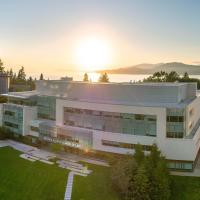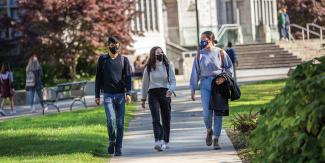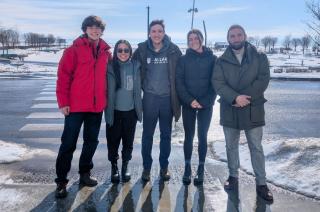Reflections on Building and then Teaching in a HyFlex Classroom at Allard Hall

Allard Law
Nov 24, 2020
Written by:
How to teach in a pandemic? This is the question we were forced to answer over the course of a weekend in March when UBC’s physical campus closed and in-person teaching was no longer possible. The pivot to the world of online teaching was abrupt and reactive; there simply wasn’t time to do anything other than keep courses going as best we could, with technology and techniques we were learning as we taught.
But how to answer that same question when given a little more time to plan? This was something that many of us at Allard Hall struggled with over the summer.
There were some constraints. In May, the University announced that most instruction in the coming academic year would be online, and the Law School informed law students that they could attend without coming to the UBC campus. As a result, we knew that courses had to be available to students online.
There were also opportunities. UBC’s Centre for Teaching, Learning and Technology provided myriad sessions, from drop-ins to multi-week courses, for us to learn and think about new methods of teaching. Some of us gained new vocabulary — synchronous vs. asynchronous teaching, for example — in which to think about what we had been doing for years, and what we might do in the future.
There was also the prospect of some in-person teaching. BC’s public health directives allowed students in classrooms, but only up to one-third of former capacity: a 50-seat classroom could have up to 15 students, so long as the 2-metre social distancing minimum could be maintained.

Could we offer opportunities for in-person instruction while also reaching those students who were online? And would the students want it if we could?
The answer to the latter question from our incoming class of first year students in response to a summer poll was a resounding yes! That, and our sense that live, in-person teaching was invaluable, spurred us to work with our colleagues, a willing administration, and a strong technical support team to build the hybrid flexible (HyFlex) classroom described below.
The HyFlex setup
The hybridity and flexibility of HyFlex refers to the capacity of students and instructors to participate in a live class either in-person or online. Our classes before the pandemic were a mix of lecture, discussion, Q&A, and individual and small group work, and our goal was to make all of this possible across a physical and virtual classroom so that everyone, whether attending in-person or online, could participate.
The first task was to ration student access to Allard Hall in order to stay within occupancy limits. The Law School already divides its incoming class of nearly 200 students into 4 sections, and teaches the first year subjects separately to each section. Numerous options were considered to further subdivide the sections, but in the end we simply divided each section into 3 subsections.
Students in each subsection have the option to attend their scheduled classes in-person for one week on a 3-week rotation. Those who attend have access to their assigned classroom for the day, and their instructors who are teaching in-person rotate through. Movement is limited. The Law Cafe and Law Library are closed, but there are a few well-spaced tables and chairs in the interaction area available for studying.
The students who are not in the classroom attend the same class online through Logitech’s Rally Video Conferencing hardware. A large screen TV, two speakers, an HD camera, and a computer sit on a trolley cart beside the instructor. Four omnidirectional microphone pods are placed around the classroom, one in front of the instructor. The computer is connected to the instructor’s Zoom or Collaborate Ultra video conference meeting. The TV screen faces the in-class students and displays online students in Gallery View. The camera captures the students in the classroom.
Instructors use a laptop computer to host the online meeting (with audio muted to prevent feedback) and it displays online students to the instructor. Its camera also provides a view of the instructor to online students. Instructors use the same computer or the room’s built-in system to display slides or other media content on the classroom screens, and the same material can be seen by online students via the Share Screen function in Zoom or Collaborate Ultra.

The photograph (above) of Professor Sam Beswick’s classroom provides a sense of how it all works. The students online can see and hear the instructor and in-class students, and when the online students participate, those in the classroom can see and hear them on the TV screen and speakers.
For small group work, we divide the students in the classroom into groups and use the Break Out Room feature for the online students.
For those students who are unable to attend (because of distant time zones, limited internet access, accessibility needs, or other reasons), we have the option to record through the video conferencing application or through the built-in lecture capture system in the classroom.
Although as many as 15 students can attend in-person, most commonly we have between 4 and 10 students sharing the physical classroom with us and 30-35 students online. Approximately half the students in our courses have attended in-person at least once.
What have we learned?
1. That online teaching/learning technology is powerful, but has significant limitations.
We’ve been pushed in new directions and learned new ways of reaching students. The technology has enabled us to build a HyFlex classroom where all the students, whether in-person or online, can participate, and in which we can lecture, use the Socratic method, and orchestrate small group work. In a sense, we’ve used the technology to recreate a space that feels much like our pre-pandemic classrooms.
But notwithstanding the speed of light, many things take more time in a digital realm than they do in the physical classroom. The spontaneity and immediacy of in-person interaction, and the energy and focus which it builds, are much more challenging to reproduce through the digital realm. Perhaps the difference is accentuated because we are seeing some students in person and so are constantly presented with the constraints of the online setting.
2. That connecting in-person is enormously satisfying.
This is hardly a revelation, but the opportunity to connect in-person with some students has been a highlight in our weeks. Moreover, we have the strong sense from informal student feedback that creating the opportunity for students to meet in person and to spend several days in a row in the Law School with their peers has itself been worth the effort.
The capacity to connect with some students in-person has also had the effect of making us feel more connected with the whole class, including the students who attend online. Although only impressionistic, we do feel that all students have benefitted from a sense of being together in the HyFlex classroom, not just the students who can attend in-person.
3. That flexibility and adaptability are huge assets when teaching and learning during the uncertainty of a pandemic.
The HyFlex model creates the option for students and instructors to attend in-person or online, and to switch between the physical and virtual classrooms over the course of the year as personal circumstances change or as the public health directives become more or less restrictive. Recording classes adds an additional element of needed flexibility for some students, although we have encouraged students to attend the live classes whenever possible.
4. That responding to the needs of differently positioned students takes thought and care and time.
The pandemic has created much uncertainty, but there seems little doubt that one of its effects has been to highlight and exacerbate existing inequalities. We were very concerned not to be compounding this effect by offering an in-person option which we knew not every student could take up. As a result, building a system that enabled online students to participate fully in the classroom was crucial. However, creating an in-person option was also part of an effort to respond to the needs of students who do not have good study spaces at home or for whom in-person interaction is integral to learning.
Zoom fatigue is a familiar phenomenon and felt more strongly by some than others. Regular breaks and a diversity of teaching methods in every class seem essential. Recording classes helps to ensure that students who face disruptions do not miss out on class content.
5. That the students are in this together with us.
The students have been remarkably understanding when we’ve fumbled with unfamiliar technology or experimented with our teaching. Moreover, we’ve been frequently delighted to hear of the back channels that students create to help us and, more importantly, each other. For the first few classes, while we were waiting on better microphones for the classrooms, the students in the classroom rotated as scribes to put up student questions and comments on the chat board to ensure their online classmates got more than just our summary of the question. When technical glitches arise (such as a power cut that hit parts of Vancouver one minute before class, causing half the online students to disappear from Zoom), in-class students took the initiative to communicate updates to their classmates. It’s clear to us that the students are helping to make this work and that without their help, it wouldn’t be working as well as it is.
6. That adapting to HyFlex teaching can be a steep — but usually short — learning curve.
We’re learning as we’re going, and although we feel much more comfortable in the world of video-conferencing than we did a few short months ago, we’re still beginners who are trying to understand its possibilities and limitations. We have complicated the exercise by combining the in-person with the video-conferencing, and sometimes find that we have to remind ourselves that we’re connecting to a divided group of learners, even as we strive to bring them together. Simple things, such as remaining in front of a camera, can be an irritation, but are important.
Final thoughts (after three months)
We are only two from a small group of instructors who have experimented with the HyFlex classroom at Allard Hall. Just as we taught differently before the pandemic imposed restrictions, so we are all building different HyFlex classrooms. Many of our other colleagues are doing marvellous things entirely online. This diversity of approaches is important, not least for the learning opportunities that it provides us.
We will certainly welcome the return to teaching without pandemic-imposed constraints. In the meantime, we feel fortunate to be able to maintain some normalcy in the classroom while we endure the “new normal” outside.
- Allard School of Law



